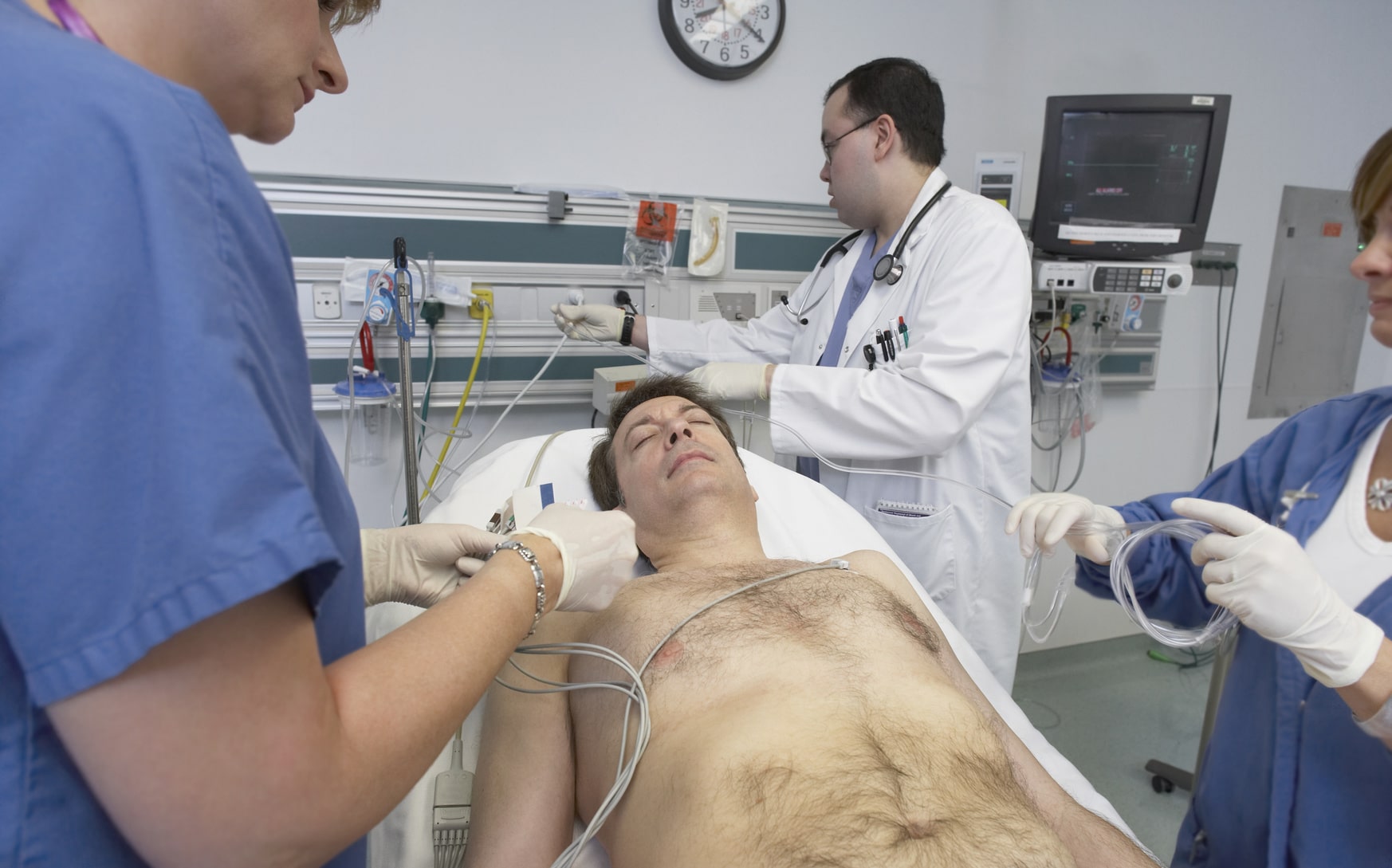Diabetic Ketoacidosis (DKA) Case Study (45 min)

Included In This Lesson
Study Tools For Diabetic Ketoacidosis (DKA) Case Study (45 min)
Outline
Mr. Logan is a 32-year-old male with a history of DM Type I. He presented to the Emergency Department (ED) after being found by his family with decreased LOC, rapid heavy breathing, and fruity breath. His family reports flu-like symptoms for the last few days.

Before even gathering further information - what do you think is going on? Why?
What diagnostic or lab tests would you expect the provider to order?
The nurse draws a Complete Metabolic Panel and notifies the Respiratory Therapist to obtain an Arterial Blood Gas. Upon further assessment, the patient is oriented x 2 and drowsy. He is breathing heavily. Lungs are clear to auscultation, S1/S2 present, bowel sounds active, pulses present and palpable x 4 extremities. A POC glucose reads >450 (meter max).
Vital signs are as follows:
HR 87
RR 32
BP 123/77
SpO2 96%
Mr. Logan’s labs result and show the following:
Glucose 804 mg/dL
K 6.1 mEq/L
BUN 39 mg/dL
pH 7.12
Cr 1.9 mg/dL
pCO2 30
Anion Gap 29 mEq/L
HCO3– 17
Urine = Positive for Ketones
Using these lab results, explain what is going on physiologically with Mr. Logan.
What is the #1 priority for Mr. Logan at this time?
The provider writes an order for an Insulin Lispro infusion IV, titrating to decrease blood glucose per protocol, 1L NS bolus NOW, and a continuous infusion of Normal Saline IV at 250 mL/hr, and to change the fluids to D5 ½ NS at 125 mL/hr once the blood glucose level falls below 250 mg/dL.
The provider adjusts the order to Regular Insulin IV infusion. Orders are also written for hourly POC glucose checks and a q2h BMP. After 4 hours and another 1L bolus of NS, Mr. Logan’s blood glucose level has dropped to 174 mg/dL, but his anion gap is still 19. The nurse changes his fluids to D5 ½ NS per the order and continues the insulin infusion. The most recent BMP showed a K of 3.7, down from 6.1, so the provider orders to give 40 mEq of KCl PO. After another 4 hours, Mr. Logan’s anion gap is now 12, a repeat ABG shows a pH of 7.36 with normal CO2 and HCO3– levels. The nurse begins to transition Mr. Logan off of the IV infusion to SubQ insulin per protocol. He is feeling much better and says he’s embarrassed that he had to be brought to the hospital.
What is the first action you should take after receiving these orders?
Why is it important to check a BMP frequently? What are we monitoring for?
Why is the insulin continued even after the blood glucose decreases?
What education can you provide Mr. Logan to help him understand why this happened and how to prevent it from recurring in the future?
Plan 1
Concepts Covered:
- Cardiovascular
- Emergency Care of the Cardiac Patient
- Cardiac Disorders
- Circulatory System
- Nervous System
- Skeletal System
- Shock
- Shock
- Disorders of the Posterior Pituitary Gland
- Endocrine
- Disorders of Pancreas
- Disorders of the Thyroid & Parathyroid Glands
- Hematology
- Gastrointestinal
- Upper GI Disorders
- Liver & Gallbladder Disorders
- Newborn Complications
- Lower GI Disorders
- Multisystem
- Neurological
- Central Nervous System Disorders – Brain
- Renal
- Respiratory
- Urinary System
- Respiratory System
- Noninfectious Respiratory Disorder
- Test Taking Strategies
- Note Taking
- Basics of NCLEX
- Prefixes
- Suffixes
- Medication Administration
- Gastrointestinal Disorders
- Respiratory Disorders
- Pregnancy Risks
- Labor Complications
- Hematologic Disorders
- Fundamentals of Emergency Nursing
- Factors Influencing Community Health
- Delegation
- Perioperative Nursing Roles
- EENT Disorders
- Basics of Chemistry
- Adult
- Emergency Care of the Neurological Patient
- Acute & Chronic Renal Disorders
- Emergency Care of the Respiratory Patient
- Respiratory Emergencies
- Studying
- Substance Abuse Disorders
- Disorders of the Adrenal Gland
- Behavior
- Documentation and Communication
- Preoperative Nursing
- Endocrine System
- Legal and Ethical Issues
- Communication
- Understanding Society
- Immunological Disorders
- Infectious Disease Disorders
- Oncology Disorders
- Female Reproductive Disorders
- Fetal Development
- Terminology
- Anxiety Disorders
- Cognitive Disorders
- Musculoskeletal Trauma
- Intraoperative Nursing
- Tissues and Glands
- Vascular Disorders
- Renal Disorders
- Eating Disorders
- Prenatal Concepts
- Microbiology
- Male Reproductive Disorders
- Sexually Transmitted Infections
- Infectious Respiratory Disorder
- Depressive Disorders
- Personality Disorders
- Psychotic Disorders
- Trauma-Stress Disorders
- Peripheral Nervous System Disorders
- Integumentary Disorders
- Neurologic and Cognitive Disorders
- Integumentary Disorders
- Newborn Care
- Basics of Mathematics
- Statistics
- Labor and Delivery
- Proteins
- Emergency Care of the Trauma Patient
- Hematologic System
- Hematologic Disorders
- Developmental Considerations
- Digestive System
- Urinary Disorders
- Postpartum Care
- Basic
- Musculoskeletal Disorders
- Bipolar Disorders
- Metabolism
- Cardiovascular Disorders
- Concepts of Population Health
- Musculoskeletal Disorders
- EENT Disorders
- Postpartum Complications
- Basics of Human Biology
- Postoperative Nursing
- Neurological Emergencies
- Prioritization
- Disorders of Thermoregulation
- Writing
- Community Health Overview
- Dosage Calculations
- Neurological Trauma
- Concepts of Mental Health
- Health & Stress
- Endocrine and Metabolic Disorders
- Childhood Growth and Development
- Prenatal and Neonatal Growth and Development
- Concepts of Pharmacology
- Integumentary Important Points
- Emotions and Motivation
- Renal and Urinary Disorders
- Developmental Theories
- Reproductive System
- Adulthood Growth and Development
- Psychological Emergencies
- Growth & Development
- Basics of Sociology
- Somatoform Disorders
- Reading
- Intelligence and Language
- Oncologic Disorders
- Med Term Basic
- Med Term Whole
- Central Nervous System Disorders – Spinal Cord
- Muscular System
- Neonatal
- Learning Pharmacology
- Pediatric
- Psychological Disorders
- State of Consciousness
- Sensory System
